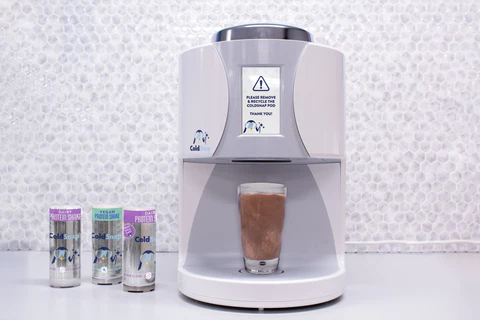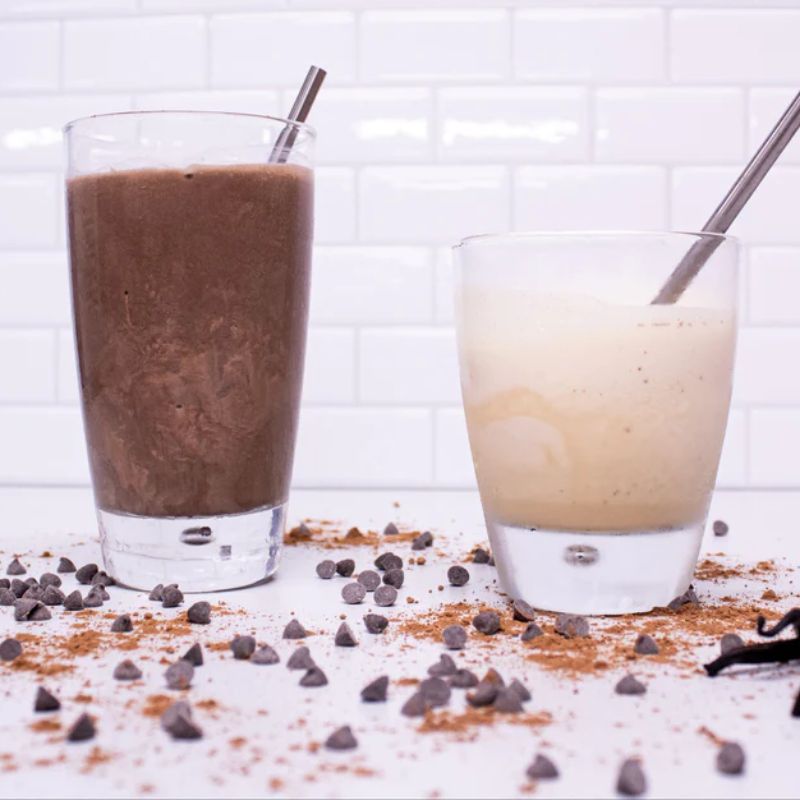When you think about protein shakes, what comes to mind? Beefy, bronzed gym caricatures in muscle shirts with veins popping from all the places? Straining to pump out just… One! More! Rep! Then re-racking the weights with a loud clang and grabbing a shaker bottle to chug down some Muscle Milk as the sweat drips. While this imagery is reminiscent of a 1980s gym commercial, for many of us it still comes to mind when we consider protein shakes.
While consumption was once mainly reserved for the ultra-fit, protein shakes are now commonplace, with an overwhelming variety of products available in refrigerated displays and on the shelves of supermarkets and convenience stores. Even if you don’t attend Globo Gym, you may be interested in the benefits of dairy protein. Extending beyond the uber-buff, protein powders can be useful for us average folk, too.
Although plant-based protein options are increasing in popularity, dairy protein powders still dominate the market. Two-thirds of the market share of protein powders is solidly in the dairy category. Here we’ll discuss some of the reasons that make dairy protein powder a compelling choice – and not just for those trying to get ripped. If you find yourself wanting to chill with a satisfying snack, ColdSnap offers delicious frozen protein shakes.
What is Dairy Protein?
Protein powder normally comes from the milk of dairy cows. Cow’s milk consists mostly of water – whole milk is 87% water. The rest is made up of protein, fat, carbohydrates, vitamins, and minerals.
Dairy protein is considered a high quality, complete protein, meaning that it contains all the essential amino acids. Amino acids are the building blocks of protein, and while the body can produce many amino acids, it can’t make all of them. Essential amino acids are those that our body needs but can’t produce – we must get them from food.
Dairy milk contains two types of protein – whey and casein. In order to manufacture protein powder, enzymes are introduced to make the milk curdle (yum). This causes the solid part of the milk, which can be used to make cheese or casein, to separate from the liquid whey. Once the whey is dried, it can be used as protein powder. Since the protein content of milk is only 3.5%, it takes a lot of milk to make protein powder – a whopping 200 liters of milk is required to produce one kilogram of whey protein powder or six kilograms of casein powder.
Whey vs. Casein
Now that we’ve got some basics down, let’s talk about a few differences between whey protein and casein. While their nutritional data are similar – a standard scoop (around 32 grams) of each contains about 24 grams of protein, one gram of fat and a few grams of carbs – whey and casein impact our body differently, due to their unique bioactive compounds.
Whey Protein
Twenty percent of the total protein in milk is made up of whey protein. Loved by athletes and weightlifters, whey is considered a “fast” protein. The body digests and absorbs it quickly and rapidly releases amino acids to the muscles. One amino acid in particular, leucine, is integral in building muscle protein. Whey is high in leucine, so it stimulates the synthesis of muscle protein. This muscle-building effect is commonly thought to be greater when whey is consumed in close proximity to a workout, though recent research calls this into question.
In addition to its fast-acting properties, the active proteins in whey, called immunoglobulins, positively impact the immune system. They have antimicrobial and antioxidant effects, and have been shown to inhibit tumor and cancer growth. Additionally, immunoglobulins help transport certain nutrients, like Vitamin A, and enhance the absorption of other nutrients, such as iron.
Casein
The remaining eighty percent of the protein in milk is made up of casein. Our bodies digest casein more slowly than whey, so our muscles get a more gradual supply of amino acids. Similar to whey, some people ascribe to the thinking that it is beneficial to time casein consumption, for example drinking a shake made with casein before bed, believing that the slow amino acid release will benefit muscle recovery and synthesis. There is some research to support this, however more research is needed.
Casein’s bioactive compounds positively impact the immune and digestive systems, can help benefit the heart and aid in the transportation and digestion of minerals such as calcium and phosphorus.
Choosing a Type of Dairy Protein
You can read some of the studies for yourself if you’re interested in the potential differences between whey and casein. While gym buffs sometimes emphasize the importance of timing their protein shakes, the strongest predictor of muscle size and strength seems to be total protein intake over the course of the day.
While it’s best to get the majority of your protein from whole foods such as lean meats, dairy products, or vegetarian options such as beans, seitan, and tofu, incorporating a protein shake into your day can be a good way to boost your intake of this important nutrient, especially if you struggle to get enough protein.
If you’re choosing between whey and casein, there are a few things to note. Casein is usually more expensive. Whey normally mixes better and often has better consistency and taste than casein. You probably won’t get stronger muscles or significant health improvements from selecting one protein over the other, so the best bet is to choose the type of protein you prefer. Another option is to purchase a blend that contains both whey and casein.

For our ColdSnap Vanilla Dairy Protein Shake, we use Milk Protein Isolate. Milk Protein Isolate is made up of whey and casein in the same proportion as milk. We selected this type of protein because it tastes great, has a smooth texture and performs well when freshly frozen in our ColdSnap machine. Since the amount of whey and casein is in the same proportion as milk, it is made of 80% casein (the slow digesting protein). This is great for curbing hunger and powering us through a workday.
What type of dairy protein powder do you prefer?
By Lyn Ferreira
Get the Scoop
Stay in the loop on all things ColdSnap with our newsletter.
Categories
Recent Posts
- ColdSnap Partners With Foodbuy to Deliver On-Demand Frozen Treats to Foodservice Operators
- Your Morning Just Got a Whole Lot Smoother: How to Make a Delicious & Healthy Smoothie with ColdSnap
- 7 Reasons Every Golf Course Needs a ColdSnap Machine
- Empowering Students with Self-Serve Frozen Treats — No Hassle, All Joy
- Ice Cream on Demand…From a Can??


